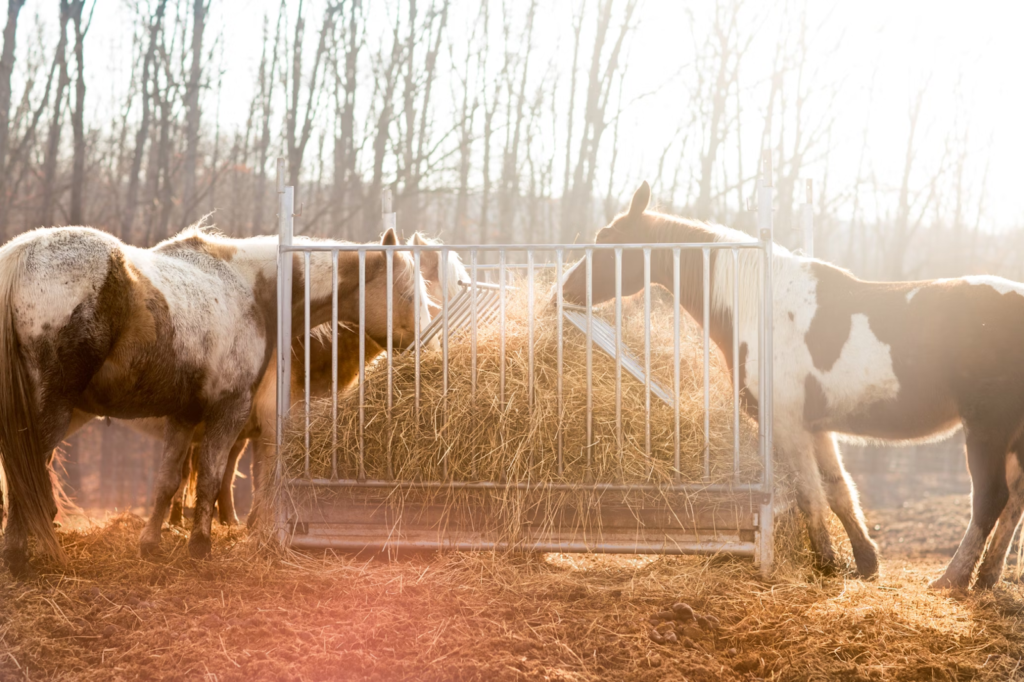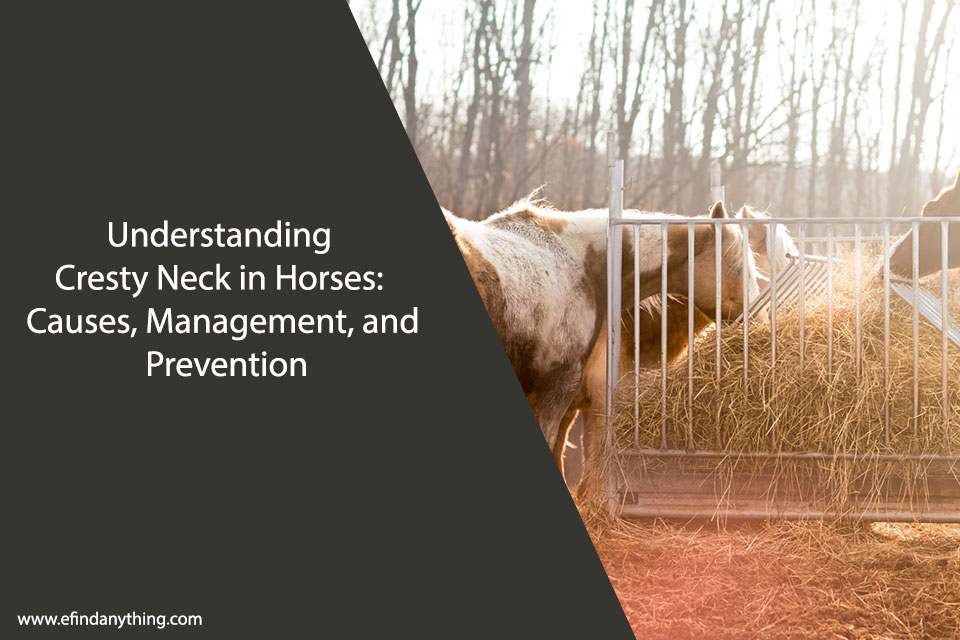
A cresty neck, sometimes called a stubborn crest, refers to an abnormal thickening and accumulation of fatty deposits along the neck crest of horses. Also known as regional adiposity, this altered fat distribution causes the neck to enlarge and protrude – creating an appearance akin to a ewe neck in sheep.
While the swollen silhouette may initially seem just an aesthetic nuisance, cresty neck development actually signals dysfunction in intricate hormonal pathways and glucose metabolism. The billowing neck crest indicates the horse’s body struggles to effectively regulate energy utilization and storage.
This metabolic disturbance underpins more troubling secondary issues like insulin resistance, increasing laminitis likelihood, emergent Cushing’s disease, reproductive problems, obesity, and accelerated cellular inflammation.
Left unmanaged, cresty neck points to eventual systemic decline that lessens the quality of life and shortens lifespan. However, prompt intervention through specialized nutritional strategies, select medications, and gradual exercise protocols can restore balance and protect well-being.
Table of Contents
Understanding the Causes
Multiple intersecting factors drive cresty neck development, mainly:
Excess Sugar and Starch Intake
Diets too high in non-structural carbohydrates like sugars and starches disrupt insulin pathways, promoting abnormal fat accumulation and weight gain. This exacerbates problems in predisposed horses. Limit non-hay feeds.
Insulin Resistance
Insulin resistance describes cells failing to respond efficiently to standard insulin concentrations, causing glucose and fat to abnormally accrue in the bloodstream rather than enter cells for energy metabolism.
Equine Metabolic Syndrome
When insulin resistance, increased neck adiposity, and the risk of laminitis occur simultaneously, it signifies Equine Metabolic Syndrome – a disorder with genetic elements that need to be managed as a lifelong condition.
Cushing’s Disease
This progressively degenerative endocrine disease impacts cortisol levels and multiple organ systems. The associated insulin resistance frequently manifests in crest fat deposits. Diagnosis is complex, but treatment can vastly slow deterioration.
Breed Predisposition
Native ponies, Morgans, Paso Finos, Arabs, Quarter Horses, and other ‘easy-keepers’ are genetically inclined to accumulate crest fat deposits and have an innately higher risk of insulin resistance – especially when overfed carbohydrates.
Implications of Cresty Neck
Aside from unsightliness, cresty neck disturbs vital systems regulation:
Increased Laminitis Risk
The hormonal and metabolic dysfunction accompanying cresty necks mean laminitis likelihood intensifies, threatening devastating hoof structure damage and permanency if not urgently controlled.
Performance Issues
The excess body fat, restricted insulin activity, and muscle loss impair strength gains and fitness, greatly limiting performance prospects in disciplines like racing and show jumping.
Reproductive Issues
Mares with metabolic conditions struggle to get in foal and carry to term. Stallions experience reduced fertility from associated testicular changes. Breeding-affected horses pass faulty genes down generations.
Health Decline
As cresty necks reflect inflammatory states and impaired organ communications, the effects compound – accelerating cell aging, organ strain, and disease progression over time. Life expectancy lessens.
Signs and Symptoms
Aside from the obvious neck crest enlargement and fat pad, monitor for:
- Rapid Weight Gain: Predisposed easy keepers abruptly pile on pounds despite no increased feed or lifestyle changes. The excess energy gets stored as fat deposits rather than fueling movement.
- Lethargy: The hormonal fluctuations and inflammation make once-active horses unusually tired, disinterested in exercise, and more prone to lying down.
- Difficulty Shedding Weight: Shedding excess adiposity becomes near impossible as the metabolism can’t efficiently access stores for energy use – the cresty neck persists stubbornly.
- Prone to Laminitis: Foot inflammation and soreness after being turned out on rich grass indicates insulin-resistant laminitis. Catching early prevents pedal bone rotation and sole detachment.
Treatment
Dietary adjustments to balance blood sugar and insulin alongside prescription medication comprise cresty neck treatment:
- Consult a Vet: Getting veterinary guidance on appropriate diagnostic testing, diet reforms and medications tailored to your horse’s needs is crucial. The earlier interventions start, the better the outcome.
- Dietary Changes: Eliminate non-structural carbohydrates, such as cereal grains, molasses, and fruit. Prioritize low NSC hays, vitamin minerals, probiotics, and higher protein/fat ratios. Gradual transitions prevent digestive upset.
- Weight Management: A slow, monitored reduction helps shed excess fatty tissue while maintaining muscle, energy, and micronutrient levels. Too rapid a drop taxes the metabolism and organs. Setting realistic goals preserves welfare.
- Exercise: Improve insulin sensitivity and gently acclimate obese, laminitis-prone horses back to light, gradual fitness regimens approved by your vet and farrier.
- Veterinary Treatments: Insulin-sensitizing drugs, like metformin and levothyroxine, are prescribed for IR and PPID to help rebalance hormone levels and blood chemistry, supporting diet and exercise efforts.
5 Tips for Managing Cresty Neck
Effectively getting a cresty neck under control requires a multi-modal approach including the following strategies:
1. Regularly Assess Neck Condition
Use the neck crest ratio method to quantify fat deposition changes over time. This involves measuring the circumference of the neck then dividing it by the width between the jaws. Aim for ratios under 2.5. Catch thickening fast.
2. Restrict High NSC Feeds
Restrict access to grain concentrates, molasses feeds, and cereal hays. Prioritize low non-structural carbohydrates hays like mature timothy, oat hay, or Bermuda grass tested at under 10% NSC while providing free-choice salt.
Gradually transition feeds over 10-14 days to allow the hindgut microbiome to adjust. Watch for signs of digestive upset like diarrhea. Provide probiotics to support intestinal health.
3. Prioritize Movement
Incorporate as much gradual physical activity suited to your horse’s current fitness and health condition under veterinary guidance – even just leisurely wandering allows muscles to utilize blood glucose and enhances insulin signaling.
Start mildly obese or previously laminitis horses with low-intensity low-intensity walking, gradually increasing duration and terrain over months before introducing more intense trotting or uphill climbs. Monitor for lameness.
4. Test For Related Disorders
Laboratory blood tests check fasting insulin, glucose, ACTH, and triglyceride levels. Results are assessed for indications of PPID, insulin resistance, liver dysfunction, or recurring laminitis. Understanding causative disorders steers treatment.
Pair bloodwork with an examination of regional adiposity patterns – crest fat accompanied by above-eye orbital or rump fat points to metabolic disturbance rather than simple obesity. Catch issues early.
5. Partner With Your Vet
Progress requires specially tailored nutritional strategies, likely involving prescription insulin-sensitizing and hormone-regulating medications, requiring close vet supervision over months and years alongside lifestyle adjustments.
Follow their lead on diagnostics, drug choice, and dosage adjustments. These should be aligned with diet reforms and exercise protocols personalized for your horse based on breed, age, and specific health vulnerabilities. Vets coordinate entire care teams.
Conclusion
In summary, cresty neck development stems from intricate disruptions in glucose, insulin, and fat-regulating pathways, indicating heightened laminitis risks and declining health. Identifying the enlarged fatty neck deposits early and intervening through veterinary-coordinated lifestyle changes and medication gives the best chance of restoring stability and protecting your horse’s wellbeing long-term against complications. Work closely with your vet and equine nutritionist.





